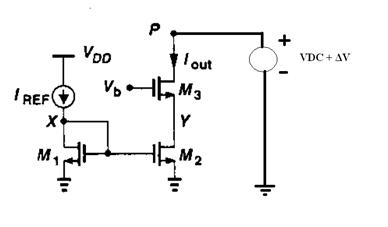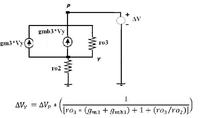palmeiras
Full Member level 6
- Joined
- Feb 22, 2010
- Messages
- 375
- Helped
- 61
- Reputation
- 122
- Reaction score
- 50
- Trophy points
- 1,308
- Location
- South America
- Activity points
- 4,199
Hi everyone,
Could someone help me with the following doubt?
I woul like to understand what is the origin of the “Shielding Property” of the cascode techinque (Device M3) in the current source shown in figure 1. The Shielding property is expected to increase the PSRR.
Do you agree with my following first explanation, composed by itens a) and b)?
a) When adding M3, there is “a voltage divider” formed by M3 and M2, and therefore, only a fraction of ΔV is transferred to node Y. Therefore, the VDS voltage of M2 is slightly changed, and the channel length modulation effect is reduced. Therefore, the advantage of cascode technique comes from the “voltage division” that is configured.
b) Now if I can consider this “voltage division”, M3 should have higher output resistance than M2 in order to have maximum rejection of ΔV.
If you don’t agree with above explanation, what is the best way to understand the PSRR improvement generated by the cascode technique?
Thank you very much,
Best regards.

Could someone help me with the following doubt?
I woul like to understand what is the origin of the “Shielding Property” of the cascode techinque (Device M3) in the current source shown in figure 1. The Shielding property is expected to increase the PSRR.
Do you agree with my following first explanation, composed by itens a) and b)?
a) When adding M3, there is “a voltage divider” formed by M3 and M2, and therefore, only a fraction of ΔV is transferred to node Y. Therefore, the VDS voltage of M2 is slightly changed, and the channel length modulation effect is reduced. Therefore, the advantage of cascode technique comes from the “voltage division” that is configured.
b) Now if I can consider this “voltage division”, M3 should have higher output resistance than M2 in order to have maximum rejection of ΔV.
If you don’t agree with above explanation, what is the best way to understand the PSRR improvement generated by the cascode technique?
Thank you very much,
Best regards.

